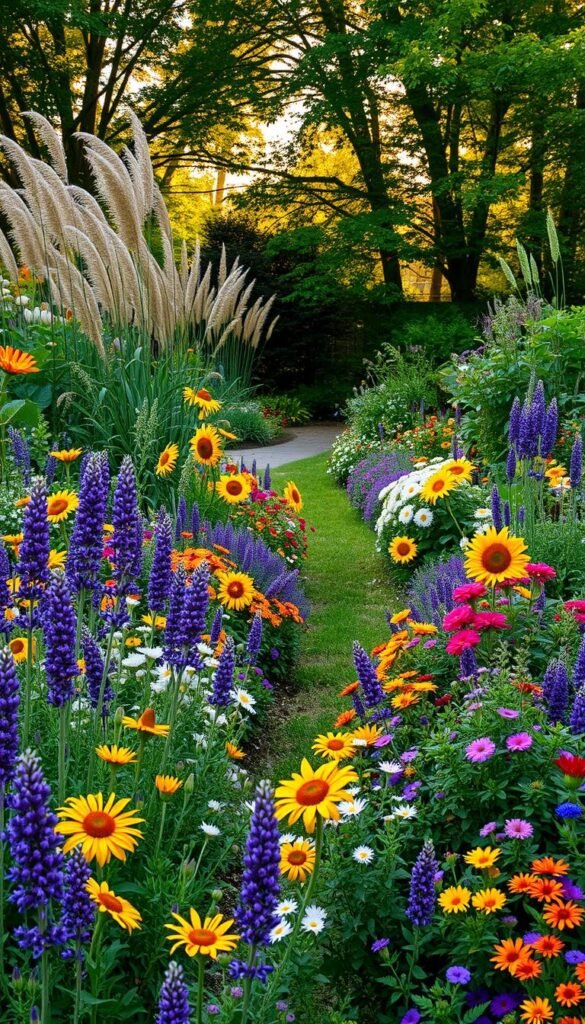Imagine stepping outside to a vibrant outdoor space that dazzles with color in every season. Creating this kind of living masterpiece isn’t magic—it’s about smart planning and understanding how plants work together. With the right mix of flowering shrubs, bulbs, and herbs, you can design a space that thrives through snow, rain, and sunshine.
Why bother? A well-curated landscape does more than look pretty. It attracts butterflies and bees, boosts nearby vegetable growth, and brightens gray winter days. You’ll also save money by reducing grocery-store flower runs—your backyard becomes a personal florist!
The secret lies in balancing plants with staggered bloom times. Early risers like daffodils kick off spring, while summer stars like lavender take over by June. As Martha Stewart’s guide to seasonal gardens explains, adding fall mums or winter holly ensures no month feels bare. Even structure matters: ornamental grasses add texture when flowers rest.
This guide will walk you through selecting hardy varieties suited to your climate, arranging them for maximum impact, and maintaining their health. You’ll learn to avoid common pitfalls and create a space that becomes your neighborhood’s pride. Ready to dig in?
Welcome to Your Year-Round Blooming Garden
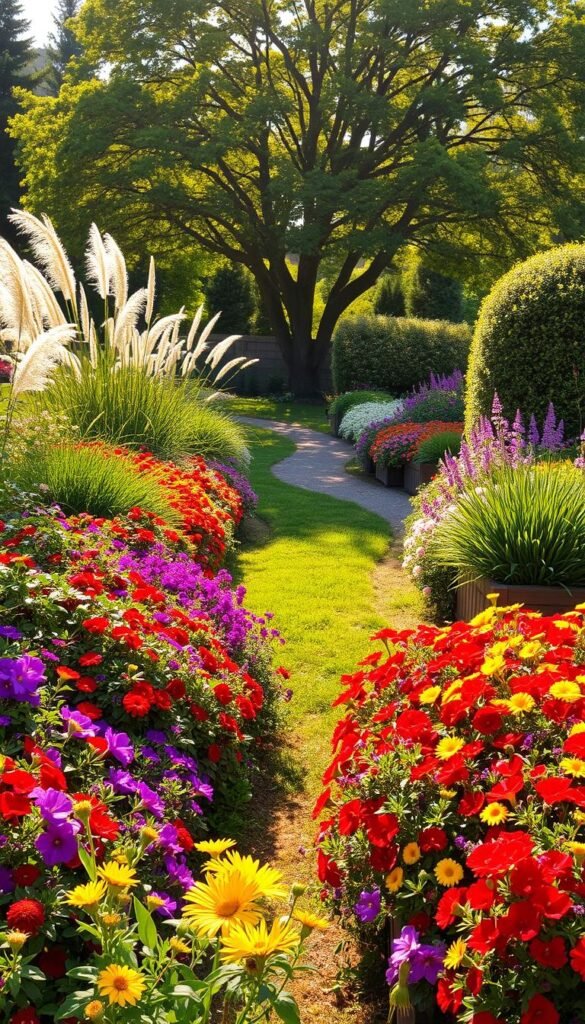
Your outdoor space is about to transform into a living canvas that changes with the seasons. Forget static flower beds—this journey lets you curate nature’s rhythm, where early crocus buds melt into summer peonies, then fiery autumn sedum. Best part? You don’t need a green thumb, just curiosity and a trowel.
Think it’s too ambitious? Not at all. Many gardeners achieve this by focusing on three simple principles: diversity, timing, and layering. Start with a mix of shrubs like hydrangeas for summer flair, then add late-blooming asters to carry the show into fall. Even winter gets love from red-twig dogwoods.
One landscaper puts it perfectly:
“A four-season space isn’t about constant flowers—it’s about creating moments that surprise and delight, even in February.”
You’ll discover how gardening becomes a creative outlet. Track bloom cycles in a notebook, experiment with color pairings, or watch bees visit your coneflowers. Each small win—like spotting your first snowdrop—fuels the next project.
Ready to begin? Grab your gloves. Your adventure in crafting a space that never sleeps starts today.
Understanding Your Garden’s Unique Conditions
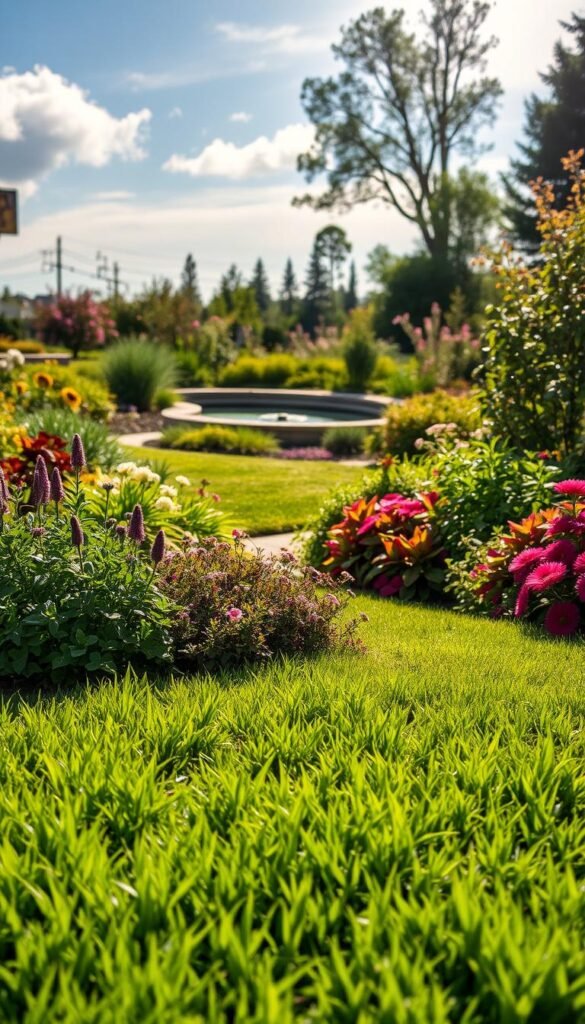
Every thriving outdoor space starts with knowing its personality. Think of your plot as a living puzzle where sun patterns, soil quirks, and microclimates shape what grows best. Before choosing plants, become a detective—your discoveries will save time and prevent heartache later.
Assessing Sunlight and Soil
Track how light moves across your space. Full-sun areas get 6+ hours daily—perfect for lavender or coneflowers. Partial shade spots? Try hostas or bleeding hearts. For soil, grab a handful. Sandy soil drains fast but needs more water. Clay holds moisture but may drown roots. Loamy mixes? Goldilocks-approved!
- Test drainage by digging a 12-inch hole and timing how long water disappears
- Use free USDA soil maps or $15 home kits to check pH and nutrients
Identifying Local Climate Factors
Your USDA zone (find yours here) reveals average winter lows. But microclimates matter too. South-facing walls trap heat, while low spots collect frost. One gardener shared:
“My back corner stays 5°F warmer—it’s where my figs survive Chicago winters!”
Watch for wind tunnels near fences or soggy areas after storms. These details help pick tough plants that laugh at local challenges. For example, if rabbits visit often, skip tulips and plant daffodils instead. Pair this knowledge with greenhouse gardening strategies to extend your growing season.
Planning for Continuous Blooming: A Primer
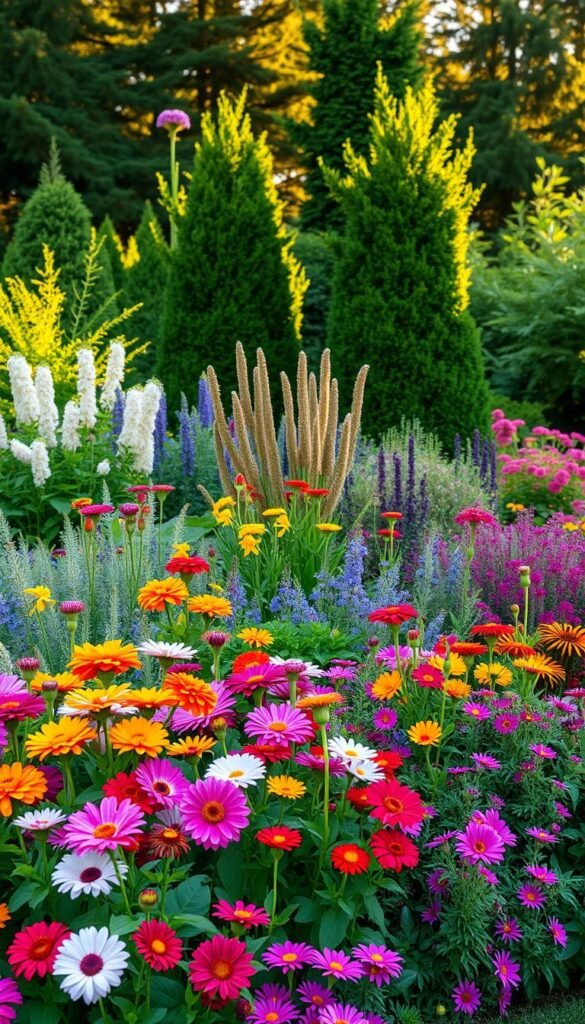
Crafting a non-stop color show starts with smart scheduling. Think of your space as a relay race where plants pass the baton of beauty from spring through winter. The trick? Pair early bloomers like creeping phlox with late stars like asters, ensuring no gaps in the action.
Start by sketching a blooming calendar. Note when each flower peaks and fades—this reveals where overlaps or holes exist. Pro tip: Include at least two varieties for each season. For example, pair summer daylilies with long-blooming black-eyed Susans to stretch the show.
Here’s how to build your timeline:
- Track bloom durations (6-week coreopsis vs. 2-week poppies)
- Group plants with staggered flowering periods in the same bed
- Place evergreens or grasses where gaps might occur
One landscaper’s secret: “I design from the front walk inward. Guests always see something flowering near paths, even if back beds rest.” This approach keeps your garden looking lively without demanding constant replanting.
Remember, flexibility matters. If crocuses fade early, fillers like pansies bridge the gap until peonies arrive. With practice, you’ll create rhythms where color flows like music—no awkward silences between seasons.
Essential Tools and Resources for Garden Planning
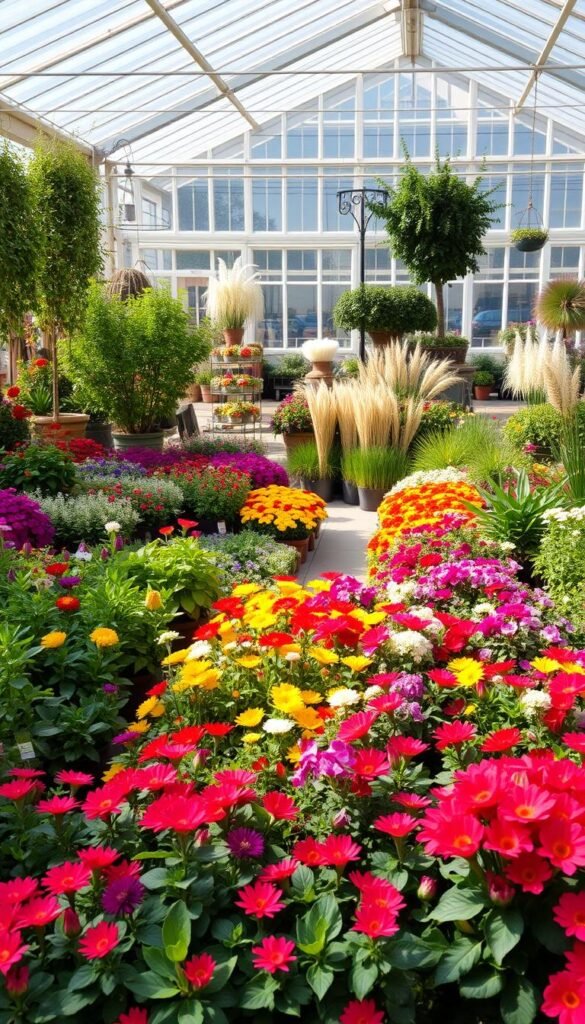
The secret to year-round color might be hiding in plain sight—at your local garden center. While spring shopping sprees feel exciting, limiting visits to one season means missing key clues about what thrives later. Think of these spots as living catalogs that rotate their displays with the weather.
Seasonal Shopping Strategies
Garden centers stock plants at their peak bloom time. Visit in summer to see vibrant coneflowers or autumn for golden mums. One nursery manager notes:
“We curate what’s thriving now. Come back every 6 weeks to discover new stars.”
Public gardens take this further, showing mature specimens in real-world conditions. Snap photos of combos you love—like sedum paired with ornamental grasses—to recreate at home.
Build relationships with staff for insider tips. Ask:
- “Which perennials handle our July heat best?”
- “Do you carry winter-interest shrubs like witch hazel?”
Track your findings in a notebook or phone app. Note bloom times, sun needs, and which critters visit. This hands-on research beats guessing games—you’ll choose plants proven to shine in your area, saving time and money.
Creating a Layout for Continuous Color
A well-structured landscape turns your outdoor area into a year-round art piece. Start by arranging taller specimens like delphiniums at the back of borders or center of island beds. Mid-height options such as salvia fill the middle layer, while creeping thyme edges the front. This “stair-step” approach lets every plant shine without competing for sunlight.
Color harmony makes or breaks the visual flow. Pair warm tones like red daylilies with cool purples for contrast, or blend analogous hues like pink phlox and magenta coneflowers. One designer suggests:
“Treat your garden like a painting—balance bold strokes with soft backgrounds.”
Bed depth matters more than you think. Allow 12 inches for roots to spread, though shallow 6-inch spaces work for compact varieties. Leave breathing room between plants—crowding leads to leggy growth and disease.
Create focal points with eye-catching combos. A cluster of yellow coreopsis beside blue nepeta draws attention, while ornamental grasses add movement. Remember: your layout will evolve as shrubs mature. Leave space for future additions, ensuring your color story grows richer each year.
Selecting Perennials That Thrive in Every Season
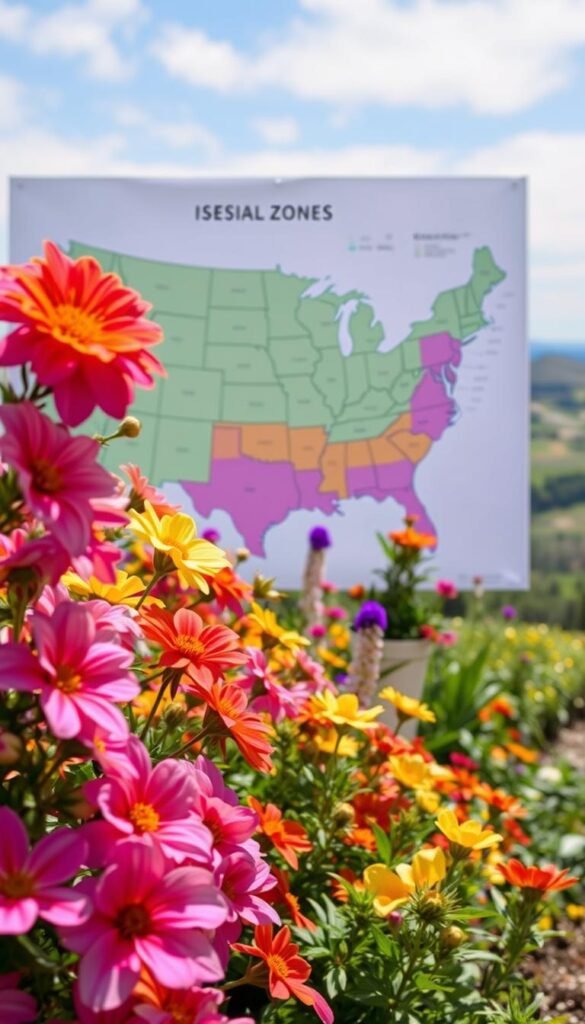
Building a four-season spectacle begins with smart plant choices. The right mix of flowering perennials creates a living calendar—each variety steps up as others fade. Start by listing candidates based on their peak times, height, and sunlight needs. This approach helps spot gaps in your seasonal lineup and ensures every corner stays lively.
Choosing Varieties Based on Bloom Times
Early risers like hellebores kick off the show in late winter, while summer stars like coneflowers shine from June onward. For fall drama, try sedum or goldenrod. Keep a cheat sheet:
- Spring: Bleeding heart (shade, medium height)
- Summer: Black-eyed Susan (full sun, tall)
- Fall: Russian sage (sun, airy texture)
Pair short-bloomers with long performers. For example, peonies dazzle briefly in late spring, but catmint flowers for months. One gardener notes:
“Overlap bloom periods by two weeks—it keeps beds looking full without effort.”
Matching Plants with Your USDA Zone
Your zone dictates survival. A Minnesota gardener learned this the hard way:
“My zone 5 plot killed ‘hardy’ English lavender rated for zone 6.”
Always check plant tags or the USDA map before buying. Southern zones? Try heat-loving salvia. Northern climates? Go with rugged yarrow.
Mix heights and light needs in each bed. Tall Joe-Pye weed towers over sun-loving coreopsis, while shade-tolerant hostas fill dim corners. Verify zone info through local nurseries—they stock proven winners for your area.
Designing with Flowering Shrubs for Multi-Season Interest
Move over, perennials—there’s a new star in town that keeps your landscape lively through every weather swing. Modern flowering shrubs bring more than just spring flowers. They deliver fireworks of fall foliage, winter berries, and sculptural branches that outshine most seasonal plants.
Today’s compact varieties pack big impact in small spaces. Think petite hydrangeas that bloom from June to frost or dwarf butterfly bushes buzzing with pollinators all summer. Even classic forsythia now comes in knee-high versions perfect for lining walkways. As one horticulturist notes:
“These aren’t your grandma’s foundation plants. New cultivars work overtime, offering color shifts from spring buds to autumn leaves.”
Use shrubs as anchor points in your design. Red-twig dogwoods add crimson branches against snowy backdrops, while viburnum offers spring blooms and fall berries. They create structure while perennials nap underground—no bare spots during transitions.
Here’s how to maximize interest:
- Pair early bloomers like lilac with late-show stoppers like oakleaf hydrangea
- Mix textures: try feathery spirea beside bold-leaved ninebark
- Layer heights—tall witch hazel behind knee-high potentilla
Smart selections ensure something’s always happening. From February’s fragrant daphne to November’s burning bush, your space stays vibrant without constant replanting. Ready to let shrubs steal the show?
Incorporating Bulbs and Annuals for Immediate Impact
While perennials form your garden’s backbone, bulbs and annuals deliver instant fireworks of color. These seasonal performers work like nature’s pop-up artists—sprinting into bloom when you need them most and bowing out gracefully when their show ends.
Spring’s Early Risers
Daffodils and tulips pierce through frosty soil weeks before trees leaf out. Their secret? Built-in energy stores let them bloom on nature’s strictest schedule. One gardener shares:
“Nothing beats crocuses emerging through snow—they’re tiny miracles announcing warmer days.”
Hide their fading foliage by planting behind late starters like daylilies or beginner-friendly phlox. This tag-team approach keeps beds tidy while transitioning to summer stars.
Annuals: The Marathon Bloomers
Petunias and zinnias thrive from May frosts until autumn’s first freeze. For nonstop color:
| Plant | Bloom Period | Pro Tip |
|---|---|---|
| Marigolds | June-October | Pinch spent flowers weekly |
| Cosmos | July-Frost | Stake tall varieties |
| Sweet Alyssum | April-November | Trim mid-summer for regrowth |
Stagger plantings every 3 weeks for constant blooms. Early spring sowings of cold-hardy pansies bridge gaps between bulb fadeouts and perennial peaks. With smart timing, your space stays vibrant while requiring minimal upkeep.
Leveraging Foliage and Ornamental Grasses for Texture and Color
Flowers grab attention, but foliage sets the stage for year-round drama. While blooms come and go, colorful leaves work overtime—their hues intensify in autumn and persist through frost. This makes them your secret weapon for creating visual depth that outlasts any single-season flower.
Plants like coleus and caladiums deliver fireworks from spring planting until winter’s first freeze. Their bold patterns and neon veins keep containers lively even when petunias fade. Pair them with trailing sweet potato vines for a cascading effect that softens edges.
| Plant | Foliage Color | Seasonal Impact |
|---|---|---|
| Coleus | Maroon/green swirls | April-November |
| Coral Bells | Purple/chartreuse | Year-round in mild zones |
| Japanese Forest Grass | Golden stripes | Spring-fall, bronze in winter |
Ornamental grasses add motion to static beds. Feather reed grass sways in summer breezes, while switchgrass turns crimson as temperatures drop. One landscaper explains:
“Grasses are nature’s punctuation marks—they give rhythm to your design when flowers take a bow.”
Use these texture champions to fill gaps in late fall. Combine blue fescue’s spiky form with mounding sedum for contrast. Even in snow, their seed heads catch frost, creating miniature winter sculptures.
By blending foliage stars with flowering plants, you craft layers that engage the eye through every season. It’s like painting with nature’s full palette—no blank canvases allowed!
Utilizing Evergreens for a Vibrant Winter Garden
Winter’s blank canvas offers surprising opportunities to keep your landscape alive with character. While other plants sleep, evergreens become the backbone of cold-weather charm. Their rich greens, blues, and golds pop against frost, while berries and textured bark add layers of visual warmth.
Choosing Evergreens with Color
Not all evergreens wear the same shade. For bold statements, try blue spruce with icy needles or golden hinoki cypress glowing like sunlight. Holly shrubs double as seasonal decor—their glossy leaves and red berries shine through December storms.
Mix textures for depth. Soft-needled white pines pair beautifully with spiky junipers. Don’t forget bark: paperbark maple peels in cinnamon curls, while red-twig dogwood branches turn scarlet when temperatures drop.
Place these champions where they’ll catch attention—near entryways or beside paths. Pair them with ornamental grasses that sway under snow or seed heads dusted with ice. Your winter space becomes a quiet showstopper, proving beauty doesn’t hibernate.

